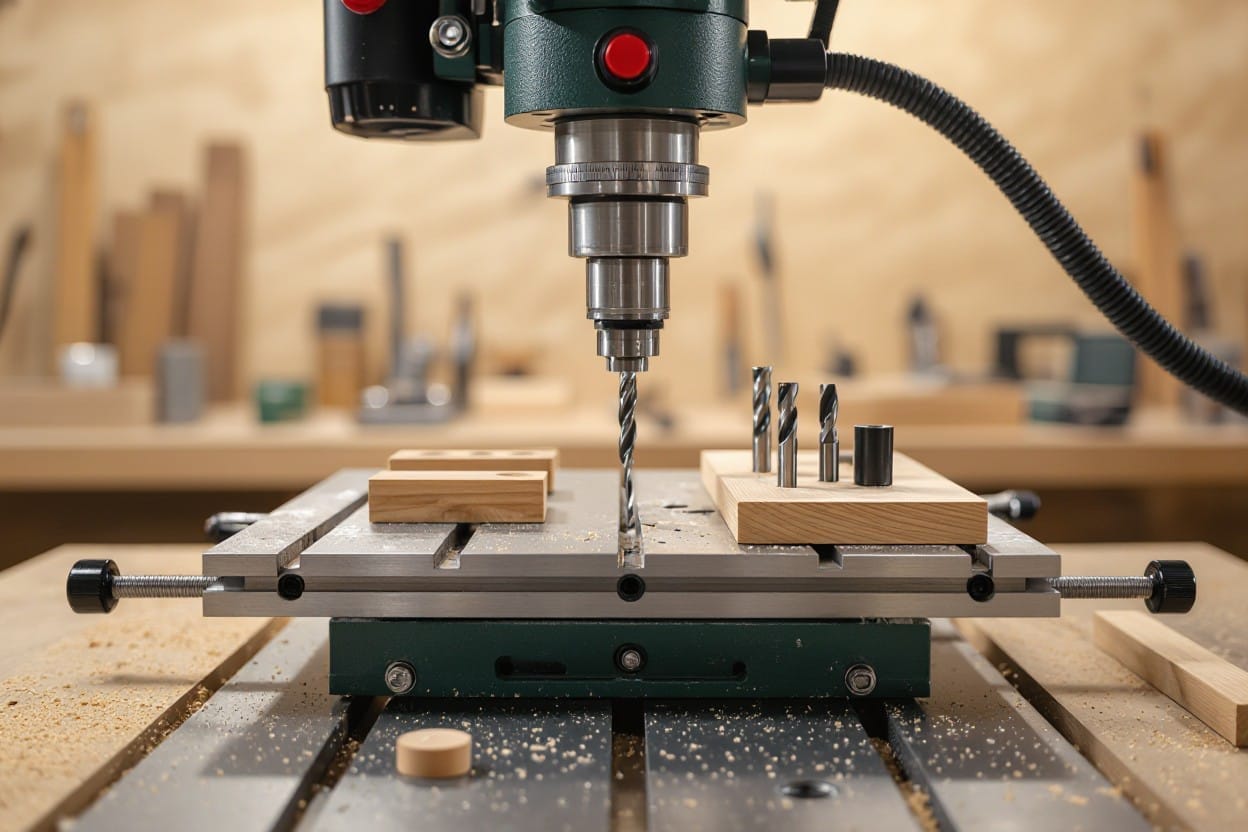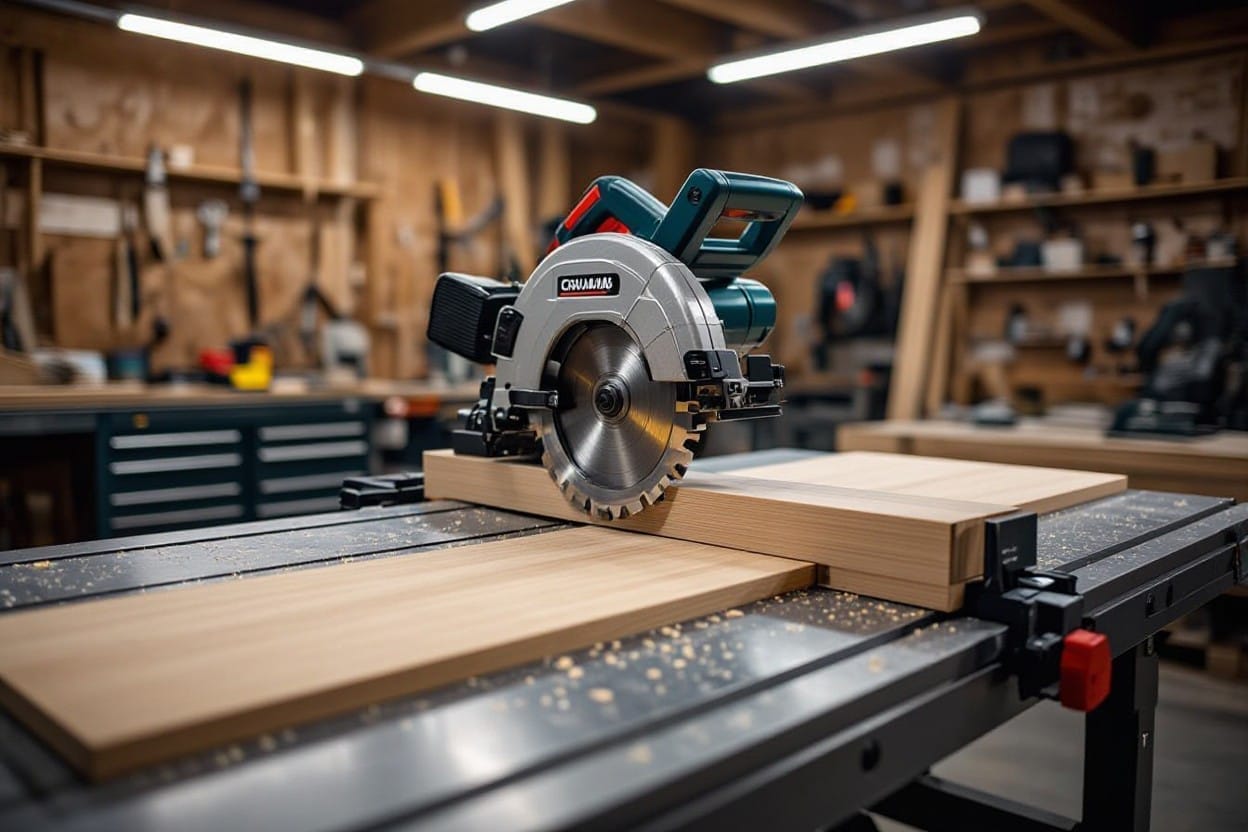Woodworker Chuck
Woodworking Jigs
There’s no better way to improve the accuracy and safety of your woodworking projects than by using custom jigs. When you build or set up the right jigs, you ensure your cuts are straight, your holes are perfectly aligned, and your parts fit together precisely. You’ll also reduce the risk of accidents by securing your workpieces firmly in place. Investing time to create reliable jigs will pay off repeatedly, helping you achieve professional-quality results while working more confidently and efficiently in your workshop.
Key Takeaways:
- Woodworking jigs enhance accuracy by ensuring cuts are straight, holes are plumb, and parts are square, contributing to better-quality projects.
- Well-made jigs save time and effort over the long term, as they can be reused repeatedly across various woodworking tasks.
- Custom jigs can be adapted or expanded—such as drill press tables with inserts or adjustable fences—to better accommodate woodworking needs versus standard metalworking equipment.

Unlocking Precision: The Power of Drill Press Tables
Many standard drill press tables fall short for woodworking tasks because they’re designed for metalworking, leaving you with limited space and a lack of backing support for through-holes. Building a layered, oversized drill press table transforms your setup, giving you a stable, larger surface with a replaceable insert that protects your work and drill bits alike. This upgrade not only enhances accuracy but also extends the life of your inserts, helping you maintain clean, precise holes every time you drill.
Crafting Your Custom Table
Stack three layers of 1/2-in. medium-density fiberboard to form a solid, 1-1/2-in.-thick table, fastened underneath your drill press’s original table with four lag screws for rigidity. The top layer is split into three sections—with outer pieces glued down and a loose center insert that's slightly narrower than the gap. Installing three adjustable flat-head screws on the insert’s side allows a snug fit, making it easy to swap or flip inserts as they wear out without compromising support or surface integrity.
Essential Features for Woodworkers
A woodworking-friendly drill press table includes a large surface area, a replaceable insert to back up through-holes, and a fence you can clamp on for guiding workpieces. The insert prevents tear-out and splintering by supporting the wood on both sides, while the fence aids in squaring and positioning material. Those three design elements together guarantee you consistent, clean, and safe drilling—far beyond what generic metalworking tables offer.
The large surface gives ample room to maneuver bigger pieces safely, reducing guesswork and enhancing stability. The loose insert, being replaceable and reversible, acts like a sacrificial wear surface that absorbs drill bit breakthrough and protects the table and workpiece edges. Meanwhile, the clamped-on fence can be repositioned or swapped for various woodworking tasks, enabling precise, repeatable holes and smooth alignment. Balancing durable materials like MDF with adjustable screws ensures both longevity and fine-tuning accuracy in your drill press setup.
Dadoes Done Right: Building the Perfect Routing Jig
Creating dadoes that fit snugly every time means dealing with variations in plywood thickness, which often falls short of the nominal 3/4 inch by about 1/32 inch. This jig’s clever design uses two parallel 1/2-in. MDF guides that you adjust to match your material’s exact thickness. Riding a top-bearing trim router bit along these guides ensures your dado is perfectly sized—neither too tight nor too loose—giving shelf and partition joints that professional finish and dependable strength.
Ensuring Accurate Joint Fit
The key to flawless dado joints lies in the adjustable pair of guides, especially the loose one that you slide against plywood test pieces. This setup locks the dado width precisely by matching your plywood’s actual thickness. By making two passes—one with the bearing on the first guide, the other on the second—you eliminate tear-out and fine-tune the cut, ensuring shelves fit squarely without unwanted gaps or forced assembly.
Step-by-Step Guide to Construction
The jig’s foundation is a frame with 3/4-in. cross members to which the guides attach. One guide is fixed firmly, while the other slides and clamps securely for adjustment. Construct both guides from 1/2-in. MDF to maintain rigidity and accuracy. The top-bearing router bit follows these guides flawlessly, so your focus should be on precise measurements when positioning and clamping the adjustable guide.
| Frame Base | Build with durable 3/4-in. lumber, ensuring a flat, stable surface and tight joints. |
| Fixed Guide | Attach firmly to the cross members; serves as the reference edge. |
| Adjustable Guide | Make loose, adjustable with clamps; slides to match plywood thickness for perfect dado width. |
| Guides Material | Use 1/2-in. MDF for straight, stable edges that control the router bit bearing precisely. |
| Router Bit | Top-bearing trim bit, 1/2 in. wide and long, with bearing flush to cutting edges. |
| Adjustment Method | Clamp two plywood test pieces against fixed guide, then tighten adjustable guide against them. |
This jig’s simplicity masks its effectiveness. Securing the adjustable guide only after confirming it fits snugly against your plywood samples removes guesswork. Using 1/2-in. MDF reduces vibration and wear, preserving the jig’s accuracy over years of use. Focus on sturdy frame construction and clean, straight edges on the guides to let the router bit track perfectly, which ultimately produces dado joints with flawless fit and exceptional strength.
Protect Your Investment: The Benefits of a Sacrificial Table Saw Fence
A sacrificial fence saves your main table saw fence from damage by taking the brunt of cuts and accidental blade contact. Made from affordable materials like MDF or plywood, it lets you confidently make rip cuts close to the blade without risking costly dents or gouges in your saw’s fence. Because this fence is replaceable, you can use all its edges until worn out, maintaining precise fence alignment and preserving your tool’s long-term accuracy and value.
Avoiding Damage to Your Main Fence
Sliding the saw’s fence too close to the blade often ends with unsightly cuts or holes in the factory fence, which warp the straight edge and ruin fence alignment. The sacrificial fence acts as a buffer, absorbing these mistakes and protecting the true fence underneath. By clamping this fence on and adjusting it alongside the blade, you keep your expensive fence smooth and perfectly flat for years.
How to Construct Your Own
Build your sacrificial fence by gluing together four layers of 1/2-inch MDF for durability, though 3/4-inch plywood also works well. Cut the middle layers into thirds to create clamping holes, ensuring that clamp heads won’t interfere during cuts. The resulting fence can be flipped or rotated, letting you maximize its lifespan. When it finally wears out, simply make a new one—quick, inexpensive, and effective.
Start with carefully cut MDF sheets, ensuring straight edges for perfect alignment. Layer and glue four pieces, paying close attention to flatness and bonding to prevent warping. After the glue sets, drill holes strategically sized for your clamps, positioned to avoid any obstruction during saw operation. The occasional flipping and rotation extend the fence’s life, making it a lasting, low-cost addition that maintains your saw’s precision and guards your investment against accidental damage.

Cutting in Style: The Versatility of a Table Saw Guide Box
The table saw guide box offers a simple yet effective way to stabilize boards standing on end, ensuring razor-sharp, straight cuts you can't easily achieve with just the saw’s fence. Crafted from melamine, this 8 in. square, 5-1/2 in. deep box attaches to optional 12-in. runners for added steadiness. It’s especially handy for cutting slots on picture frame parts for spline joinery. Clamping the workpiece within the box eliminates movement, while the adjustable supports let you tackle angled or 90-degree cuts with absolute confidence.
Enhancing Stability for Vertical Cuts
Supporting vertical pieces during cuts prevents wobbling that leads to inaccurate or dangerous results. The box’s block, screwed inside, braces the workpiece firmly against the fence, while a toggle clamp secures the lower end where traditional clamps can’t reach easily. This setup absorbs cutting forces, so your hands stay clear of the blade and your cuts stay absolutely straight.
Customizing for Various Applications
Flexibility comes from swapping out supports—remove the 45-degree brace and install a 90-degree block to switch between angled spline cuts and tenons. Clamping options let you adjust the box to hold oddly shaped or smaller pieces securely. These features expand the jig’s usefulness far beyond a single task, making it a versatile addition to your table saw arsenal.
Further customization includes adding different-sized blocks or runners to accommodate larger workpieces or unique shapes. For example, taller supports can help you cut deeper tenons, while removable inserts permit cutting through complex moldings. You might even modify the box base to include non-slip pads or sacrificial inserts to protect its surface as you push long or rough materials. This adaptability ensures you keep precision and safety no matter the job.
Eliminating Wobbles: The No-Wiggle Miter Gauge Method
Wobbles in your miter gauge bar translate directly into inaccurate crosscuts and frustration. Connecting two miter gauges with a rigid fence stabilizes your setup, ensuring absolutely straight cuts every time. This jig doubles the surface contact and reduces lateral play, giving you a solid, repeatable guide. It’s a simple modification that transforms shaky cuts into precise, professional results, especially helpful for fine joinery or repetitive crosscutting tasks.
DIY Miter Gauge Construction
Craft your own miter gauge by gluing two Baltic birch plywood pieces into an L-shape, then attaching a snug-fitting bar cut from maple or 1/4-in. tempered hardboard. Use spring clamps to hold the bar at a perfect 90-degree angle while the glue cures, adjusting for a tight fit in your saw’s miter slot. Screws added afterward lock the assembly together, producing a durable, custom gauge tailored precisely to your table saw.
Safety Enhancements for Your Setup
Adding a plastic shield to your fence acts as a visual and physical barrier between your fingers and the spinning blade. Since this jig generally prevents you from using the saw’s original guard, the shield also blocks flying sawdust. Position it so it doesn’t interfere with your work but clearly reminds you to keep hands clear—small safety measures like this significantly reduce the risk of accidents during operation.
Beyond serving as a finger guard, the plastic shield can be fashioned from clear polycarbonate sheets, allowing you to maintain visibility while protecting yourself. Secure it firmly to prevent shifting during cuts, and consider slightly angling it toward your body to deflect debris downward. This addition complements hearing protection and eye wear, rounding out a safer woodworking environment without compromising precision or convenience.
Squaring Up: The Importance of Squaring Blocks in Cabinetmaking
Using squaring blocks during cabinet assembly guarantees that each corner forms a perfect 90-degree angle, preventing twisted or misaligned cases that can ruin door and drawer fits. By clamping these blocks to adjacent sides before applying final pressure with your clamps, you maintain consistent squareness throughout glue-up. This simple jig saves hours of rework and delivers professional results every time you build a case.
Crafting Effective Squaring Blocks
Cut a plywood block about 8 inches square, ensuring the inside corner is perfectly square using a combination square for accuracy. Attach two 3/4-in. by 2-3/4-in. by 7-in. lips to adjacent edges for clamping. Leave a small gap at the corner so excess glue can be cleaned without interference. This design holds firmly without damaging your workpieces and provides consistent squaring throughout multiple glue-ups.
Best Practices During Assembly
Clamp the squaring blocks firmly against the cabinet’s adjacent sides before applying final clamp pressure. Place the glue-up on a flat surface to reduce sagging, and tighten clamps incrementally to keep blocks aligned. Cleaning squeezed-out glue promptly prevents it from bonding the blocks to your workpiece, allowing easy removal. Applying a little wax or packing tape to the block’s clamping surfaces can help prevent stickiness and prolong the block’s usability over time.
Additionally, watch for subtle shifts when tightening clamps; uneven pressure can knock the squareness off by a fraction, causing gaps or misaligned doors later. Using multiple blocks on longer cases or placing blocks at both ends can prevent racking. You might also combine these blocks with cauls to distribute clamp force evenly, maintaining both squareness and panel flatness simultaneously. This hands-on approach minimizes guesswork and ensures your cases come out square and stable every time.
To wrap up
Taking this into account, woodworking jigs are indispensable tools that enhance your precision, efficiency, and safety in the workshop. By investing time to create and use these jigs, you ensure consistently accurate cuts, well-fitted joints, and smoother workflows. Whether you’re drilling, routing, sawing, or clamping, the right jig simplifies complex tasks and improves the quality of your projects. With thoughtful jig design and proper setup, you’ll find your woodworking experience becomes more enjoyable and your results more professional.
FAQ
Q: What are the main benefits of using woodworking jigs in my workshop?
A: Woodworking jigs help ensure accuracy and consistency in your projects by guiding tools and workpieces for straight cuts, precise holes, and square joints. They reduce errors, save time by simplifying repetitive tasks, and improve the overall quality of finished pieces. Since jigs can be reused for many years, they are a valuable investment that enhances efficiency and craftsmanship.
Q: How can I maintain and extend the life of my drilling jig inserts?
A: Jigs with removable inserts, such as drill press tables, allow you to flip or slide the insert to expose fresh surfaces when worn. Making several extra inserts means you can replace them when they become deeply worn or full of holes. Using materials like medium-density fiberboard (MDF) for the inserts offers a balance of durability and ease of replacement. Properly securing the inserts with adjustable screws ensures a snug fit and helps maintain jig precision.
Q: Can I make custom jigs for different woodworking tasks without professional tools?
A: Yes, many effective woodworking jigs can be made using basic tools and affordable materials like plywood, MDF, and hardwood offcuts. For example, you can build simple squaring blocks, adjustable fences, or sacrificial fences to enhance your workshop’s capabilities. Careful measuring, cutting, and assembly are key to creating jigs that improve accuracy and ease of use, even if you don’t have access to advanced machinery.
JOIN MY MAILING LIST
Hey, I’m Chuck…

I'm a 55-year-old carpenter with over 20 years of experience in creating custom furniture for family, friends, and clients alike. My passion for woodworking runs deep, and I take pride in blending traditional craftsmanship with modern techniques to produce pieces that are as functional as they are timeless. Sustainability matters to me, so I always choose high-quality, eco-friendly materials for every project. I love sharing my experiences, tips, and favorite products with fellow woodworking enthusiasts. Whether you're looking for inspiration or advice on your next project, I'm here to help guide you on your own woodworking journey.
Copyright © 2025 Woodworker Chuck | All Rights Reserved.
This website is not part of the Meta, Instagram, or Facebook.
Additionally, this site is not endorsed by Meta, Instagram, or Facebook in any way.
Facebook and Instagram are trademarks of Meta Platforms, Inc.

